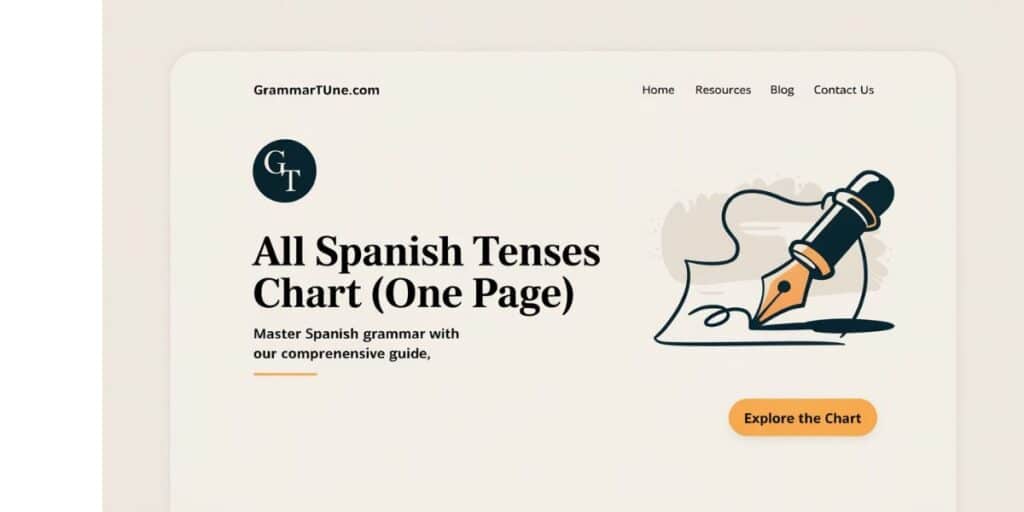All Spanish Tenses Chart (One Page) is your go-to resource for mastering Spanish verb conjugations quickly and clearly. Whether you’re just starting out or brushing up, this chart covers Spanish tenses, moods, and forms—all in one spot .
From present tense to subjunctive mood, and preterite to future tense, every key form is here. This guide helps you learn faster and remember longer. With a single glance, you’ll see how verbs shift across Spanish grammar, making study time easier and more effective. Let’s simplify Spanish together—one tense at a time.
Tense Chart provided by Spanish411.net 📊
If you’re serious about learning Spanish, this chart from Spanish411.net is gold.
It lays out every major Spanish tense in a clean, easy-to-use format.
Perfect for quick reviews or deep study sessions 📚
You won’t find a better one-page Spanish verb tenses chart.
It’s designed for all levels—beginner to advanced learners.
Use it daily to build your confidence and speed 🏃♂️💬
Must read: Nighttime vs. Night Time: Understanding the Difference ????
Standards ✅
This chart follows strict Spanish grammar standards used in schools and exams.
Everything aligns with real-world usage and official language guidelines.
So, you’re not just memorizing—you’re mastering 🎓
Whether you’re studying for DELE or AP Spanish, it fits your needs.
Its structure supports both casual learners and formal students.
Learn the right way, from the start 📘
What Are the Spanish Tenses? ⏳
Spanish tenses show when actions happen—past, present, or future.
They help shape time and meaning in every sentence you say.
Mastering them means you express yourself clearly 🗣️
There are 18 total tenses, and each has a purpose.
Some are simple, others are compound (two-part).
Together, they bring your Spanish to life! ✨
Which Are the Spanish Moods? 😃😟🤔
Moods in Spanish show the speaker’s attitude toward the action.
There are three main types: indicative, subjunctive, and imperative.
Each one changes the feel of your message 💬
The indicative mood is used for facts.
The subjunctive handles emotions, doubts, and hopes.
The imperative gives commands—short and strong! 💥
Download Your 18 Spanish Tenses Cheat Sheet! 📥🧠
Get your Spanish tenses cheat sheet to study anytime, anywhere.
It’s a one-page snapshot of all the essentials—super handy!
Perfect for quick reference while doing homework or practice 📄
Just click, save, and print.
It’s free, clean, and easy to follow.
You’ll wonder how you studied without it before 🙌
Master the 18 Spanish Tenses 🧩💪
Each of the 18 Spanish tenses unlocks a new level of fluency.
Learn them step-by-step and practice with real examples.
Soon, you’ll form accurate sentences without thinking twice 😎
Focus on one tense at a time.
Then combine them to express complex thoughts.
This builds confidence and natural fluency 🔄
Indicative Mood Simple Tenses 📘
These simple tenses show real events happening now or in the past/future.
They’re the foundation of everyday Spanish conversations.
Start here for rock-solid basics 🧱
You’ll use the present, preterite, imperfect, future, and conditional tenses.
They’re straight to the point—no helper verbs needed.
Great for daily life and storytelling 🗓️
Present 🕒
The present tense talks about what’s happening right now.
It’s one of the most used forms in the language.
Example: Yo hablo español (I speak Spanish).
Use it for routines, habits, or facts.
It’s your go-to tense for introductions and everyday talk.
Master this one early on! 🗣️
Preterite 🔙
The preterite tense tells us what happened—once, completely, in the past.
Example: Ayer comí pizza (I ate pizza yesterday).
Great for stories and specific actions.
Use it when the action is finished and time is clear.
It’s one of two key past tenses in Spanish.
Keep it sharp and snappy! 🍕
Imperfect 🔄
The imperfect tense describes past actions that were repeated or ongoing.
Example: Cuando era niño, jugaba mucho (I used to play a lot).
It paints a picture of the past.
It works well for setting scenes or describing habits.
Unlike the preterite, it’s more about feelings and flow.
Think of it as your storytelling brush 🖌️
Future 🔮
With the future tense, talk about what will happen.
Example: Mañana estudiaré español (Tomorrow I’ll study Spanish).
Simple structure, big impact.
It’s perfect for plans, predictions, or promises.
Plus, it’s one of the easiest tenses to learn.
Add -é, -ás, and you’re good! ✍️
Conditional 🤔
Use the conditional tense to talk about what would happen.
Example: Yo viajaría más si tuviera tiempo (I would travel more if I had time).
It’s ideal for wishes and hypotheticals.
It often shows up in polite requests too.
It’s soft, thoughtful, and full of nuance.
Practice this one for richer conversations 🌍
Indicative Mood Compound Tenses 🧠🔗
These tenses use haber + a past participle.
They help you describe completed actions with a time twist.
Start using them to sound more advanced 👓
You’ll meet perfect tenses here—each tied to time and mood.
Learn how to say “I have done” or “She had left.”
Great for expressing life events and experiences 🎯
Present Perfect ✅
Say what has happened with the present perfect.
Example: He comido (I have eaten).
It connects past events to now.
Great for recent actions and personal news.
This tense adds depth to your stories.
A must-have in your speaking toolkit 🧰
Preterite Perfect 📖
Rare but good to know—the preterite perfect is formal.
It’s used more in literature than speech.
Example: Hube terminado (I had finished).
Think of it as extra precise.
You won’t use it daily, but it’s helpful for reading.
Nice to know when you’re digging deep 📚
Past Perfect 🧳
The past perfect talks about what had happened.
Example: Había salido cuando llamaste (I had left when you called).
Used to set up past sequences.
It helps your storytelling flow better.
You’ll find it in longer explanations or flashbacks.
It makes the timeline crystal clear ⏱️
Conditional Perfect 💭
Use the conditional perfect for actions that would have happened.
Example: Habría ido si me invitabas (I would’ve gone if you invited me).
A “what if” tool for regrets or hypotheticals.
This tense adds emotional weight and realism.
It’s great for reflective thoughts and deep chats.
Get cozy with it—it’s a gem 🔮
Future Perfect 🚀
With the future perfect, talk about what will have happened.
Example: Habré terminado para las 5 (I’ll have finished by 5).
Used when you’re projecting into the future.
Perfect for deadlines or long-term plans.
It’s fancy but simple once you see the pattern.
Smooth and professional ✨
Take Note 📝
Some tenses sound alike—watch out for mix-ups!
Verb endings and time clues make all the difference.
It’s okay to go slow and review.
Also, spoken Spanish may skip some tenses.
But knowing all helps you read and write better.
It’s about being well-rounded 💯
Subjunctive Mood Simple Tenses 😬🌈
The subjunctive is where Spanish shows its soul.
It expresses hopes, doubts, desires, and emotion.
Different rules, but so worth learning.
Start with these simple tenses: present, two imperfects, and future.
They don’t state facts—they suggest possibilities.
Beautifully complex and expressive 💖
Present 💌
Use the present subjunctive for wishes or uncertainty.
Example: Espero que vengas (I hope you come).
It’s emotional and polite.
It’s triggered by phrases like “quiero que” or “ojalá.”
One of the most used subjunctive forms.
Get the rhythm—it’ll click 🪘
Imperfect 1 📚
This subjunctive imperfect form follows past-tense triggers.
Example: Si tuviera dinero, viajaría (If I had money, I’d travel).
Great for hypotheticals.
It’s a grammar staple for serious learners.
Build fluency with conditionals and storytelling.
Practice it with “si” clauses often!
Imperfect 2 🧾
Less common but equally valid, this form ends in -se.
Example: Si yo fuese rico (If I were rich).
It sounds a bit more formal or literary.
Still heard in songs, speeches, and some regions.
Good to know both versions for full understanding.
Use it to impress! 🎤
Future 🌠
Super rare—the future subjunctive is mostly historical.
You might see it in old texts or legal writing.
Example: Donde estuviere (Wherever he may be).
Modern Spanish barely uses this form.
But if you’re reading older literature, it pops up.
Just recognize it—you don’t need to master it.
Subjunctive Mood Compound Tenses 🧩💬
These are like perfect tenses, but in the subjunctive mood.
They describe actions tied to emotion, hope, or condition.
Use them to deepen your fluency.
They’re used in sentences with “que” and mood triggers.
You’ll learn present perfect, past perfect 1 & 2, and future perfect.
Each adds depth to how you feel in Spanish 🎭
Present Perfect 💡
Say what may have happened using this tense.
Example: Espero que hayas comido (I hope you’ve eaten).
Emotion meets recent action.
It’s used after present-tense triggers.
So keep your timeline clear.
Great for conversations and storytelling.
Past Perfect 1 🪞
This one shows what had happened in a subjunctive context.
Example: Ojalá hubiera llegado antes (I wish he had arrived earlier).
Full of feeling and regret.
Perfect for hypotheticals in the past.
Often followed by “si” or “ojalá.”
Expresses what could have been.
Past Perfect 2 🧾
Like version 1, but ends in -se forms.
Example: Si hubiese sabido… (If I had known…).
Sounds slightly more formal or poetic.
Both versions are correct and often interchangeable.
Learn both so you’re never confused.
Adds elegance to your Spanish 💫
Future Perfect 🌈
Used to say what might have happened in the future.
Very rare in speech, but it exists.
Example: Hubiere terminado (He may have finished).
Mostly used in literature or legal Spanish.
Just good to recognize for advanced reading.
No stress if you skip it in conversation.
You will like: Resignate or Resonate Correct Term and Proper Use in 2025
Practice Your Spanish Tenses 📝💬
Practice makes progress—not perfection, but fluency.
Mix drills with real conversation.
Write, speak, and repeat!
Use flashcards, apps, or journals in Spanish.
The more you use tenses, the more natural they feel.
Language is a muscle—keep flexing! 💪🇪🇸
Present Spanish Tenses 🌞
The present tenses are where it all begins.
They help you talk about daily routines and facts.
Think of them as your go-to for conversations!
You’ll use them to express actions happening now.
They’re simple, yet incredibly powerful.
Great for beginners and fluent speakers alike 🗣️
Present Simple Tense 🔹
The present simple tense shows actions happening now or regularly.
Example: Yo estudio cada día (I study every day).
It’s clean, direct, and essential.
Use it for habits, facts, and general truths.
This tense is the heartbeat of a beginner Spanish.
Get comfy with it early!
Present Simple Spanish Tense Regular Verb Chart: 📊
Here’s a quick look at how regular -ar, -er, and -ir verbs change:
| Subject | -AR (hablar) | -ER (comer) | -IR (vivir) |
| Yo | hablo | como | vivo |
| Tú | hablas | comes | vives |
| Él/Ella | habla | come | vive |
| Nosotros | hablamos | comemos | vivimos |
| Vosotros | habláis | coméis | vivís |
| Ellos | hablan | comen | viven |
Practice these daily and they’ll stick! 📒
Past Spanish Tenses ⏳
Past tenses help you talk about memories, stories, and events.
Spanish has two key ones: preterite and imperfect.
Each one paints the past in a different light.
One is sharp and clear, the other smooth and flowing.
Together, they help you tell full, rich stories.
Let’s dive into both!
Past Preterite Tense 🔙
The preterite tense expresses actions that are done and over.
It’s great for one-time events or specific timeframes.
Example: Ayer fui al cine (I went to the movies yesterday).
Use it when you’re telling a story with plot points.
Short, punchy, and full of action.
Think of it as the timeline maker 📍
Past Preterite Spanish Tense Regular Verb Chart 🧾
| Subject | -AR (hablar) | -ER (comer) | -IR (vivir) |
| Yo | hablé | comí | viví |
| Tú | hablaste | comiste | viviste |
| Él/Ella | habló | comió | vivió |
| Nosotros | hablamos | comimos | vivimos |
| Vosotros | hablasteis | comisteis | vivisteis |
| Ellos | hablaron | comieron | vivieron |
You’ll use this a lot in stories and recaps! 🎙️
Past Imperfect Tense 🌫️
The imperfect tense describes repeated or ongoing past actions.
Example: Cuando era niño, leía mucho (When I was a kid, I used to read a lot).
It’s smooth and descriptive.
It’s great for feelings, background info, and childhood memories.
The mood is mellow and reflective.
Very poetic and soft-spoken 📜
Past Imperfect Spanish Tense Regular Verb Chart 📝
| Subject | -AR (hablar) | -ER/-IR (comer/vivir) |
| Yo | hablaba | comía / vivía |
| Tú | hablabas | comías / vivías |
| Él/Ella | hablaba | comía / vivía |
| Nosotros | hablábamos | comíamos / vivíamos |
| Vosotros | hablabais | comíais / vivíais |
| Ellos | hablaban | comían / vivían |
Use this for storytelling depth! 🌌
Future Spanish Tenses 🔮
Talking about the future in Spanish? Easy!
There are two main ways to do it: inflection or using ir + infinitive.
Both work, but they feel a little different.
Future tense is great for plans, predictions, or hopes.
It gives you power to dream and commit.
Let’s break them down!
Future Inflection 🚀
This is the formal way to say what will happen.
Example: Estudiaré mañana (I will study tomorrow).
You just add endings to the whole verb.
It’s easy and consistent—same endings for all verb types.
Perfect for sounding polished and confident.
You’ll use it a lot!
Spanish Future Inflection Regular Verb Chart: 📅
| Subject | -AR/-ER/-IR (viajar/comer/vivir) |
| Yo | viajaré / comeré / viviré |
| Tú | viajarás / comerás / vivirás |
| Él/Ella | viajará / comerá / vivirá |
| Nosotros | viajaremos / comeremos / viviremos |
| Vosotros | viajarás / comeréis / viviréis |
| Ellos | viajarán / comerán / vivirán |
Same endings, less stress! 💯
Future with “ir” ➡️
The ir + a + infinitive construction is super common.
Example: Voy a comer (I’m going to eat).
It’s casual and used in everyday speech.
Perfect for plans and quick intentions.
Think of it like “gonna” in English.
Easy, useful, and natural 🗣️
Conditional Future / Past Future 🤔
Use the conditional tense to talk about what would happen.
It works for both polite requests and future-in-the-past ideas.
Example: Viajaría contigo (I would travel with you).
Very handy in storytelling or expressing regret.
It’s flexible and expressive.
And yes, it’s also used in “what if” scenarios!
Spanish Conditional Inflection Regular Verb Chart: 💭
| Subject | -AR/-ER/-IR (viajar/comer/vivir) |
| Yo | viajaría / comería / viviría |
| Tú | viajarías / comerías / vivirías |
| Él/Ella | viajaría / comería / viviría |
| Nosotros | viajaremos / comeríamos / viviríamos |
| Vosotros | viajarías / comeréis / viviríais |
| Ellos | viajarán / comerían / vivirían |
Elegant and emotional 💌
Spanish Subjunctive Mood 💬
This mood isn’t about facts—it’s about feelings.
Use the subjunctive for doubt, desire, and possibility.
It gives your Spanish heart and depth ❤️
Triggered by expressions like quiero que or ojalá.
It’s tricky at first, but super useful.
Let’s get into the present and past forms.
Present Subjunctive 🌟
Use the present subjunctive when the main verb is in present tense.
Example: Espero que vengas mañana (I hope you come tomorrow).
Soft, polite, and powerful.
Change endings and switch vowels (ar ↔ er/ir).
It’s used all the time in conversation.
Emotions take the lead here 🎭
Spanish Present Subjunctive Regular Verb Chart: 🧪
| Subject | -AR (hablar) | -ER/-IR (comer/vivir) |
| Yo | hable | coma / viva |
| Tú | hables | comas / vivas |
| Él/Ella | hable | coma / viva |
| Nosotros | hablemos | comamos / vivamos |
| Vosotros | habléis | comáis / viváis |
| Ellos | hablen | coman / vivan |
Get used to that switch! 🔄
Past Subjunctive 🕰️
Use it after a past verb or in “if” statements.
Example: Si tuviera dinero (If I had money).
There are two common forms.
They mean the same, but the endings differ.
Choose whichever fits your voice or region.
Let’s see them both.
Spanish Past Subjunctive Regular Verb Chart (Version 1): 🧾
| Subject | -AR/-ER/-IR (hablar/comer/vivir) |
| Yo | hablara / comiera / viviera |
| Tú | hablaras / comieras / vivieras |
| Él/Ella | hablara / comiera / viviera |
| Nosotros | habláramos / comiéramos / viviéramos |
| Vosotros | hablarais / comierais / vinierais |
| Ellos | hablarán / comieran / vivieran |
Spanish Past Subjunctive Regular Verb Chart (Version 2): 🧾
| Subject | -AR/-ER/-IR (hablase/comiese/viviese) |
| Yo | hablase / comiese / viviese |
| Tú | hablases / comieses / vivieses |
| Él/Ella | hablase / comiese / viviese |
| Nosotros | hablásemos / comiésemos / viviésemos |
| Vosotros | hablaseis / comieseis / vivieseis |
| Ellos | hablasen / comiesen / viviesen |
Use either one—just stay consistent!
Other Useful Spanish Grammatical Tools 🧠
Beyond tenses, there are other tools you’ll need.
Think aspects, irregulars, and conditional forms.
They refine your grammar like a pro.
Use them to express ongoing, completed, or potential actions.
Pair these with context for full fluency.
It’s the next step in your mastery 🏁
Perfect Aspect ✔️
Shows completed actions tied to another moment.
Great for saying “has done” or “had eaten.”
It’s all about timing ⌚
Progressive Aspect 🔄
Talk about what’s happening right now.
Uses estar + gerund like Estoy hablando (I’m talking).
Perfect for live action updates 🎥
Conditional Spanish Formations 📐
Want to sound thoughtful and polite? Use conditionals.
Structure: whole verb + ía endings.
Easy to form, powerful in use.
Irregular Conjugations ⚠️
Watch out! Some verbs break the rules.
Ir, ser, estar, tener—know them well.
Practice makes them second nature.
You will like: Other Ways to Say “Happy Sunday”
Learn Spanish Tenses in Context with Clozemaster 🎮
Want to see tenses in real-life use?
Check out Clozemaster.
It helps you learn Spanish tenses in real sentences.
It’s gamified, fast, and fun.
Perfect for practice on the go.
Tense learning becomes second nature! 🧠
Conclusion
Mastering Spanish verbs doesn’t have to be overwhelming. With the All Spanish Tenses Chart (One Page), everything you need is right at your fingertips—clear, organized, and easy to follow. Whether you’re learning the present tense, reviewing the preterite, or diving into the subjunctive mood, this chart keeps it simple.
Use it as a daily reference or a quick refresher before practice. It’s perfect for students, travelers, and language lovers alike. Learn faster, remember more, and speak with confidence—one tense at a time. ✅🇪🇸
FAQ,S
What’s the best way to learn Spanish tenses?
Start with regular verbs, then practice daily using charts and real examples.
How many tenses are in Spanish?
There are 18 main tenses across different moods: indicative, subjunctive, and imperative.
What’s the difference between preterite and imperfect?
Preterite shows completed actions, imperfect describes ongoing or repeated past events.
Do I really need to learn the subjunctive?
Yes! It’s essential for expressing emotions, doubts, and polite speech.
Which tense should beginners start with?
Begin with the present simple tense—it’s the foundation of everyday conversation.

Joulia, a seasoned wordsmith and grammar enthusiast, brings over a decade of blogging expertise to Grammar Tune. With a keen eye for linguistic precision and a passion for making complex grammar concepts accessible, he has helped thousands of readers enhance their writing skills. His engaging teaching style and practical approach to language learning have made him a trusted voice in the online grammar community.







